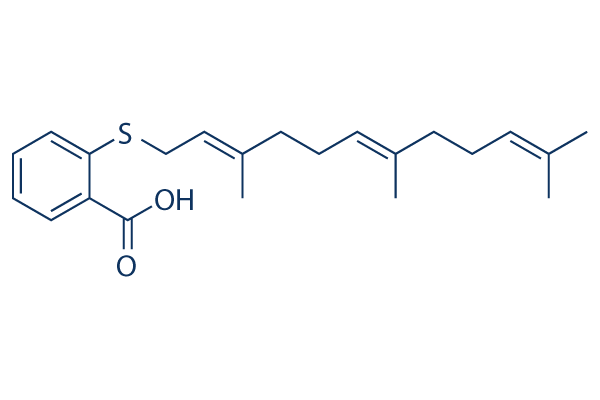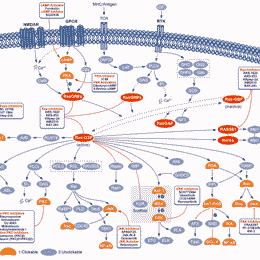
- Bioactive Compounds
- By Signaling Pathways
- PI3K/Akt/mTOR
- Epigenetics
- Methylation
- Immunology & Inflammation
- Protein Tyrosine Kinase
- Angiogenesis
- Apoptosis
- Autophagy
- ER stress & UPR
- JAK/STAT
- MAPK
- Cytoskeletal Signaling
- Cell Cycle
- TGF-beta/Smad
- DNA Damage/DNA Repair
- Compound Libraries
- Popular Compound Libraries
- Customize Library
- Clinical and FDA-approved Related
- Bioactive Compound Libraries
- Inhibitor Related
- Natural Product Related
- Metabolism Related
- Cell Death Related
- By Signaling Pathway
- By Disease
- Anti-infection and Antiviral Related
- Neuronal and Immunology Related
- Fragment and Covalent Related
- FDA-approved Drug Library
- FDA-approved & Passed Phase I Drug Library
- Preclinical/Clinical Compound Library
- Bioactive Compound Library-I
- Bioactive Compound Library-Ⅱ
- Kinase Inhibitor Library
- Express-Pick Library
- Natural Product Library
- Human Endogenous Metabolite Compound Library
- Alkaloid Compound LibraryNew
- Angiogenesis Related compound Library
- Anti-Aging Compound Library
- Anti-alzheimer Disease Compound Library
- Antibiotics compound Library
- Anti-cancer Compound Library
- Anti-cancer Compound Library-Ⅱ
- Anti-cancer Metabolism Compound Library
- Anti-Cardiovascular Disease Compound Library
- Anti-diabetic Compound Library
- Anti-infection Compound Library
- Antioxidant Compound Library
- Anti-parasitic Compound Library
- Antiviral Compound Library
- Apoptosis Compound Library
- Autophagy Compound Library
- Calcium Channel Blocker LibraryNew
- Cambridge Cancer Compound Library
- Carbohydrate Metabolism Compound LibraryNew
- Cell Cycle compound library
- CNS-Penetrant Compound Library
- Covalent Inhibitor Library
- Cytokine Inhibitor LibraryNew
- Cytoskeletal Signaling Pathway Compound Library
- DNA Damage/DNA Repair compound Library
- Drug-like Compound Library
- Endoplasmic Reticulum Stress Compound Library
- Epigenetics Compound Library
- Exosome Secretion Related Compound LibraryNew
- FDA-approved Anticancer Drug LibraryNew
- Ferroptosis Compound Library
- Flavonoid Compound Library
- Fragment Library
- Glutamine Metabolism Compound Library
- Glycolysis Compound Library
- GPCR Compound Library
- Gut Microbial Metabolite Library
- HIF-1 Signaling Pathway Compound Library
- Highly Selective Inhibitor Library
- Histone modification compound library
- HTS Library for Drug Discovery
- Human Hormone Related Compound LibraryNew
- Human Transcription Factor Compound LibraryNew
- Immunology/Inflammation Compound Library
- Inhibitor Library
- Ion Channel Ligand Library
- JAK/STAT compound library
- Lipid Metabolism Compound LibraryNew
- Macrocyclic Compound Library
- MAPK Inhibitor Library
- Medicine Food Homology Compound Library
- Metabolism Compound Library
- Methylation Compound Library
- Mouse Metabolite Compound LibraryNew
- Natural Organic Compound Library
- Neuronal Signaling Compound Library
- NF-κB Signaling Compound Library
- Nucleoside Analogue Library
- Obesity Compound Library
- Oxidative Stress Compound LibraryNew
- Plant Extract Library
- Phenotypic Screening Library
- PI3K/Akt Inhibitor Library
- Protease Inhibitor Library
- Protein-protein Interaction Inhibitor Library
- Pyroptosis Compound Library
- Small Molecule Immuno-Oncology Compound Library
- Mitochondria-Targeted Compound LibraryNew
- Stem Cell Differentiation Compound LibraryNew
- Stem Cell Signaling Compound Library
- Natural Phenol Compound LibraryNew
- Natural Terpenoid Compound LibraryNew
- TGF-beta/Smad compound library
- Traditional Chinese Medicine Library
- Tyrosine Kinase Inhibitor Library
- Ubiquitination Compound Library
-
Cherry Picking
You can personalize your library with chemicals from within Selleck's inventory. Build the right library for your research endeavors by choosing from compounds in all of our available libraries.
Please contact us at info@selleckchem.com to customize your library.
You could select:
- Antibodies
- Bioreagents
- qPCR
- 2x SYBR Green qPCR Master Mix
- 2x SYBR Green qPCR Master Mix(Low ROX)
- 2x SYBR Green qPCR Master Mix(High ROX)
- Protein Assay
- Protein A/G Magnetic Beads for IP
- Anti-Flag magnetic beads
- Anti-Flag Affinity Gel
- Anti-Myc magnetic beads
- Anti-HA magnetic beads
- Poly DYKDDDDK Tag Peptide lyophilized powder
- Protease Inhibitor Cocktail
- Protease Inhibitor Cocktail (EDTA-Free, 100X in DMSO)
- Phosphatase Inhibitor Cocktail (2 Tubes, 100X)
- Cell Biology
- Cell Counting Kit-8 (CCK-8)
- Animal Experiment
- Mouse Direct PCR Kit (For Genotyping)
- New Products
- Contact Us
research use only
Salirasib Ras inhibitor
Salirasib (Farnesylthiosalicylic acid, FTS) is a potent competitive prenylated protein methyltransferase (PPMTase) inhibitor with Ki of 2.6 μM, which inhibits Ras methylation. This compound exerts antitumor effects and induces autophagy. Phase 2.

Chemical Structure
Molecular Weight: 358.54
Purity & Quality Control
Batch:
Purity:
99.69%
99.69
Related Products
| Related Targets | H-ras N-ras K-ras Ral | Click to Expand |
|---|---|---|
| Related Products | ARS-1620 Adagrasib (MRTX849) ARS-853 BI-3406 MRTX1133 BAY-293 K-Ras(G12C) inhibitor 12 RBC8 Kobe0065 KRpep-2d BQU57 BI-2852 CID-1067700 (ML282) | Click to Expand |
| Related Compound Libraries | Kinase Inhibitor Library PI3K/Akt Inhibitor Library MAPK Inhibitor Library DNA Damage/DNA Repair compound Library Cell Cycle compound library | Click to Expand |
Signaling Pathway
Mechanism of Action
| Targets |
|
|---|
In vitro |
||||
| In vitro | Salirasib inhibits the growth of human Ha-ras-transformed Rat1 cells, which correlates well with their inhibition for PPMTase. [1] This compound inhibits Ras methylation in Rat-1 fibroblasts, Ras-transformed Rat-1, and B16 melanoma cells. It also reduces the levels of Ras in cell membranes and inhibits Ras-dependent cell growth, independently of methylation, but via modulation of Ras-Raf communication. [2] In Ras-transformed EJ cells, this chemical interferes with the activation of Raf-1 and MAPK and inhibits DNA synthesis. [3] | |||
|---|---|---|---|---|
| Kinase Assay | PPMTase Assays | |||
| Synaptosomal membranes of rat brain cerebellum or total membranes of cultured cell lines (100,000 × g pellet) are used for methyltransferase assays in the cell-free systems. Methyltransferase assays are performed at 37°C in 50 mM Tris-HCl buffer, pH 7.4, using 100 μg of protein, 25 μM [methyl-3H]AdoMet (300,000 cpm/nmol), and 50 μM AFC (prepared as a stock solution in DMSO) in a total volume of 50 μL. DMSO concentration in all assays is 8%. Various concentrations of this compound are used in several experiments as indicated in the text. Reactions are terminated after 10 min by addition of 500 μL of chloroform:methanol (1:1) with subsequent addition of 250 μL of H2O, mixing, and phase separation. A 125-μL portion of the chloroform phase is dried at 40°C, and 200 μl of 1 N NaOH, 1% SDS solution is added. The methanol thus formed is counted by the vapor phase equilibrium method. Typical background counts (no AFC added) are 50-100 cpm, while typical reactions with this chemical yield 500-6,000 cpm. Assays are performed in triplicate, and background counts are subtracted. Methylation of endogenous substrates and gel electrophoresis are performed. Protein carboxyl methylation in intact cells is determined using 100 μCi/mL [methyl-3H]methionine. Cells are assayed in near confluent cultures grown in 10-cm plates with 5 mL of labeling medium. | ||||
| Cell Research | Cell lines | PC12, CHE, T-antigen-transformed CHE, endothelial cells, astrocytes, B16, Rat1, EJ, NIH3T3, v-Raf-transformed NIH3T3 cell lines | ||
| Concentrations | ~100 μM | |||
| Incubation Time | 10 days | |||
| Method | Cells are grown in 24-well plates. 2 h after plating, the cells receive either solvent or this compound freshly prepared from a stock solution to yield the final indicated concentrations in 0.1% DMSO. Media are replaced every 4 days with fresh medium containing the solvent or the drug. Separate experiments indicate that the solvent itself has no effect on cell growth. On the indicated days, the cells are detached from plates by trypsin/EDTA and counted under the light microscope. All assays are performed in quadruplicate. In parallel experiments, cells are stained either with trypan blue or with MTT, and the stained cells are examined under the light microscope. In some MTT-stained cultures, the cells are dissolved in 0.2 mL of 100% DMSO, and the extent of staining is determined spectrophotometrically using an enzyme-linked immunosorbent assay reader. | |||
In Vivo |
||
| In vivo | In Panc-1 xenografted nude mice, Salirasib (5 mg/kg i.p.) markedly inhibits tumor growth without systemic toxicity. [4] In male Wistar rats, this compound markedly inhibits thioacetamide-induced -induced liver cirrhosis. [5] In the dy(2J)/dy(2J) mouse model of congenital muscular dystrophy, this chemical attenuates fibrosis and improves muscle strength. [6] | |
|---|---|---|
| Animal Research | Animal Models | Panc-1 xenografted nude mice |
| Dosages | 5 mg/kg daily | |
| Administration | i.p. | |
References |
|
Chemical Information
| Molecular Weight | 358.54 | Formula | C22H30O2S |
| CAS No. | 162520-00-5 | SDF | Download SDF |
| Synonyms | Farnesylthiosalicylic acid, FTS | ||
| Smiles | CC(=CCCC(=CCCC(=CCSC1=CC=CC=C1C(=O)O)C)C)C | ||
Storage and Stability
| Storage (From the date of receipt) | |||
|
In vitro |
DMSO : 72 mg/mL ( (200.81 mM) Moisture-absorbing DMSO reduces solubility. Please use fresh DMSO.) Ethanol : 72 mg/mL Water : Insoluble |
Molecular Weight Calculator |
|
In vivo Add solvents to the product individually and in order. |
In vivo Formulation Calculator |
|||||
Preparing Stock Solutions
Molarity Calculator
In vivo Formulation Calculator (Clear solution)
Step 1: Enter information below (Recommended: An additional animal making an allowance for loss during the experiment)
mg/kg
g
μL
Step 2: Enter the in vivo formulation (This is only the calculator, not formulation. Please contact us first if there is no in vivo formulation at the solubility Section.)
% DMSO
%
% Tween 80
% ddH2O
%DMSO
%
Calculation results:
Working concentration: mg/ml;
Method for preparing DMSO master liquid: mg drug pre-dissolved in μL DMSO ( Master liquid concentration mg/mL, Please contact us first if the concentration exceeds the DMSO solubility of the batch of drug. )
Method for preparing in vivo formulation: Take μL DMSO master liquid, next addμL PEG300, mix and clarify, next addμL Tween 80, mix and clarify, next add μL ddH2O, mix and clarify.
Method for preparing in vivo formulation: Take μL DMSO master liquid, next add μL Corn oil, mix and clarify.
Note: 1. Please make sure the liquid is clear before adding the next solvent.
2. Be sure to add the solvent(s) in order. You must ensure that the solution obtained, in the previous addition, is a clear solution before proceeding to add the next solvent. Physical methods such
as vortex, ultrasound or hot water bath can be used to aid dissolving.
Tech Support
Answers to questions you may have can be found in the inhibitor handling instructions. Topics include how to prepare stock solutions, how to store inhibitors, and issues that need special attention for cell-based assays and animal experiments.
Tel: +1-832-582-8158 Ext:3
If you have any other enquiries, please leave a message.
* Indicates a Required Field






































